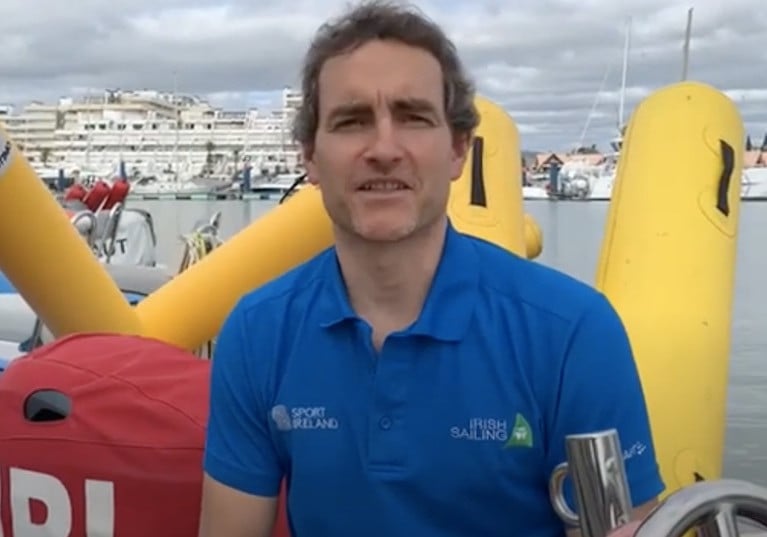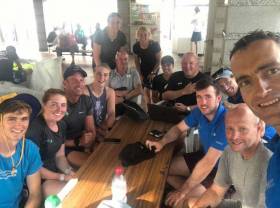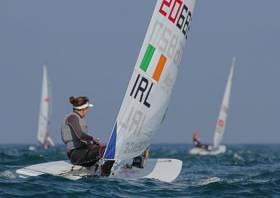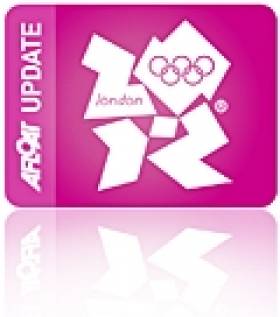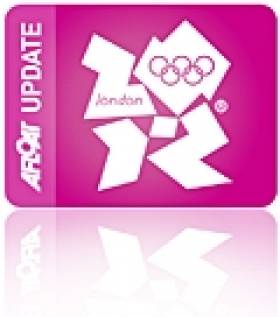Displaying items by tag: Irish Olympic sailing
Irish Olympic Sailing: Time for a Different Tack
Irish Olympic performances have again failed to meet expectations, writes Roger Bannon, so perhaps the High-Performance support structure needs to be changed.
In the wake of the Tokyo Olympics, it seems very timely for some dispassionate reflection on Ireland's sailing performance. This time, we had three representatives in 2 disciplines, including our 2016 Silver Medallist in Rio, Annalise Murphy and the very talented pairing of Dickson and Waddilove, in the 49er.
Despite winning two races in her preferred windy conditions, Annalise failed to perform to her usual high standards and finished well outside the qualification criteria for the final medal race. The 49er team had an outstanding regatta which included two race wins in this incredibly competitive fleet, finally finishing just outside the medal race qualification after being forced to discard two excellent race results because of a technical weight infringement on a trapeze harness, an extraordinary oversight.
This overall disappointing performance was also marred by controversy about the fairness of the altered selection criteria for the Laser Radial slot and the withdrawal of the long-term coaching support for the 49er team after they won the U23 World Championships in 2020. Our justified Rio performer, Finn Lynch, failed to qualify for the Men's Laser and the 49er FX talent Saskia Tidey, former Irish representative in the 49er FX class in Rio, transferred her allegiance to the British sailing team.
By any objective analysis, these outcomes are incredibly disappointing.
The current High-Performance Unit is basically comprised of the same senior personnel since 2006. This backroom team has presided over Irish participation at 4 Olympics since 2008. Apart from Annalise Murphy's silver medal in Rio, an exceptional result for a variety of reasons, Irish results at all these Olympics have failed to fulfil our much-heralded promise. Annalise's four race wins without a medal in London 2012 and the failure of the very fancied Star Boat team at the same event illustrate our disappointments very clearly.
There is a growing clamour for a review of Irish Sailing's High-Performance division. Annalise's silver medal in 2016 was a reflection of her dedication, her unique physique and undoubted exceptional talent in windy conditions. Her performance in Rio was also enhanced by her decision to independently retain the services of a specialist New Zealand coach, which was financially supported by a sponsor procured with the assistance of fellow members of the National Yacht Club in Dun Laoghaire. A widely held perception in Ireland is that Annalise's achievements have masked serious shortcomings elsewhere in our Olympic Sailing stable.
It is estimated that at least €15m has been spent since 2006 on High-Performance Sailing in Ireland, excluding what the participants themselves have contributed.
The Government regularly spends more supporting Irish sailing than any Olympic sport other than Athletics, a windfall which is unlikely to continue after our poor results in Tokyo and consistent disappointments in the past.
Ireland is not unique in being disappointed with its performance in Tokyo. The USA failed to win any medals, despite being a major sailing country. They have recognised that big changes have to be made, and they have appointed Paul Cayard, a world-class Olympic and International sailor, to become their high-performance supremo. Cayard had this to say on his appointment: "Many of us in America are dissatisfied by our Olympic sailing trend and want to correct our course. While being in the middle of the pack is not a bad thing, it is just not how Americans think of themselves. Moving up the Olympic pecking order is not going to be easy. No one is going to get out of our way. We need to build a machine that puts teams and athletes in a position where their usual routine will produce a podium result on a regular basis. This is about cultivation, education, preparation and execution on game day. This is about proper process and procedure."
In a recent interview, Keith Musto, Silver medallist at the 1964 games in Tokyo in the Flying Dutchman class, offered his analysis as to why the UK is so dominant in the Olympics.
He asserted that without a good national base of active dinghy racing with an integrated training and coaching structure, it is difficult to consistently produce high quality talent. The RYA recently appointed the renowned Olympic and international sailor Ian Walker as their high-performance supremo to direct what they hope will be the ongoing British dominance in Olympic sailing, demonstrating their willingness to review and change even an outstandingly successful high-performance structure which has delivered so many medals over the last 12 years.
Where does that leave Irish Sailing?
I presume the mission statement for the HP is to deliver medals at the Olympics (without using any of the financial resources of Irish Sailing) by basically relying on direct Government funding and private fund-raising efforts.
We need to re-examine how these precious financial resources are deployed. The Financial Statements of Irish Sailing illustrate that most of the discretionary funding is spent on infrastructural costs such as salaries, capital equipment and overheads, with a relatively small percentage being used to directly support athletes, unless independently allocated under the carding system by the Sports Council.
To be fair, Irish Sailing has regularly nurtured a coterie of very talented youth sailors who have performed outstandingly at the international level, but it is also clear we have a problem with subsequently developing this talent at the senior level and providing the support these athletes need when attending major events. We have basically not changed our approach for the last four or five Olympic cycles, and the core methodology is obviously not working and needs to be totally reappraised, probably with new blood and revised structures.
Informed commentary from former and aspiring Olympians and younger talent suggest the following issues need to be addressed;
- We need to professionalise our coaching support techniques to improve performance at each Olympics. This may require investment in senior appointments from outside the narrow base of coaches in Ireland. Listening to Billy Walsh, the former Irish Boxing Coach now managing the Olympic Boxing team for the USA, outline how to do this in a comprehensive interview recently on Newstalk revealed a level of attention to detail which was astonishing.
- We should regularly peer-review ourselves against other more successful nations of similar size, such as New Zealand.
- High-performance sailors should not be isolated from mainstream domestic sailing activities.
- Our HP sailors must win the hearts and minds of all sailors in Ireland, which will encourage an esprit de corps which will attract proper fundraising and goodwill from the general sailing public.
- Enhanced PR, controlled accessibility to athletes, improved relations with young athletes' families together with independent accountability for major decisions would represent badly-needed improvements to the current set-up. Importantly, the existing aura of secrecy must change.
- There is an urgent need for the HP area to develop protocols to assist in improving communication and consultation with families that support young athletes attempting to gain traction at the international level. A review of all legal documentation required to be signed by all participants in HP activities is also urgently needed as many believe some of the undertakings are unreasonable and unfairly onerous.
- It is undoubtedly time for major changes to the composition of the High-Performance Olympic Committee. Too many members have been around for far too long during a period when little success was achieved.
Repeating the same decisions will not change the outcome. We have less than 3 years to go to Paris so changes need to be taken promptly. Using the argument that making changes will be disruptive does not make sense, Disruption is what we need and, in the meantime, we must nurture the raw talent we have - in the 49er Team, the Laser Radial and the Men's Laser - and find ways to disseminate the technical know-how and expertise acquired by our HP sailors as we attempt to raise standards on a more widespread basis.
Sport Ireland has to be looking at Irish Sailing with a seriously jaundiced perspective. They will likely also have identified the need for a different approach and will expect the hierarchy in Irish Sailing to be sufficiently aware of the urgent need for serious changes. Constant failure to deliver on promises whilst recklessly talking up the future, eventually has its day.
It's time for some imaginative and material changes. This is probably best achieved by an independent review of the High-Performance area, the conclusions of which are ultimately published to encourage debate within the Irish Sailing community on how best to proceed in the future with our Olympic aspirations.
Roger Bannon is a former President and Treasurer of the Irish Sailing Association
With 'Uncertainty in the Air', Irish Olympic Sailors 'Plough Ahead' for Tokyo 2021
Irish Olympic Sailing boss James O’Callaghan was in climes sunnier than the team’s Dun Laoghaire Harbour Olympic Sailing HQ when he reported back to the Olympic Federation of Ireland last week on successful results achieved at January's training regatta in the Canary Islands.
As Afloat reported previously, Annalise Murphy took fifth overall in the ILCA Six class and Finn Lynch seventh in the ILCA Seven class at the Lanzarote Winter Series, a regatta that grew in significance in the pandemic. As the international calendar is disrupted for a second year, the January event gave Murphy, Lynch and other Irish campaigners the chance to be back on the race course for the first time since October's European Championships in Poland.
It is reported that conditions in Lanzarote are very similar to those the sailors will face in Hiroshima, Tokyo, where the sailing events of the next Olympic Games will be held in late July. So much so, that even Japanese teams have decided to change their home for the Canary Islands to prepare for the big event. "Lanzarote is very similar to Hiroshima, with a lot of wind and big waves. Moreover, here we have sun, good weather every day and a lot of activities that allow us to prepare ourselves outside of the water as well. That is why we decided to come to the Canary Islands," says Eri Hatayama, a Japanese Nacra 17 sailor.
The Team Ireland Performance Director for Sailing said it was a ‘great opportunity to continue the training’ and to 'keep the sailors busy and focussed on the job'.
O’Callaghan said there was some ‘uncertainty in the air’, as the Olympic circuit was curtailed by COVID. It's a situation made even more uncertain by the fact that Ireland has only one boat qualified (Laser Radial/ILCA Six) for Tokyo so far. The two other berths Ireland still seeks are totally reliant on Euro qualification regattas, one of which was postponed last week.
Having missed earlier qualification chances as far back as 2018 Ireland’s chances are now tied to the onset of the pandemic across Europe and the hope that the remaining places can be settled by racing rather than historical results as the staging of the Games itself comes under scrutiny.
For the moment, O'Callaghan says he is 'ploughing ahead' with team plans.
See the youtube clip below.
Annalise Murphy's Lanzarote Winter Regatta
Meanwhile, the National Yacht Club's Murphy has given her own candid assessment of her Canary Island performance on social media.
In an honest review, uncomplicated by coach-speak, the Rio medalist declared "I am very happy with some aspects of my sailing but somehow I can still be a total idiot when racing, even though I feel that at 30 years of age I should be making less stupid mistakes!"
She signed off the Instagram self-appraisal by thanking the host club and congratulating Denmark's Anne Marie Rindom on her Lanzarote victory, a sailor Murphy beat in Rio to win Olympic silver four years ago.
Irish Olympic Sailors Line Out for Tokyo 2020 Test
Irish Olympic Sailing campaigners are now in Japan with two big events in Enoshima. With only one Irish boat qualified and a year to go to the Olympic regatta itself, the race is well and truly on to try and get more Irish sailors at the Games. Ireland ultimately hopes to contest four classes. Taking place between 15-22 August 2019 at Enoshima Yacht Harbour, the official Tokyo 2020 Olympic Sailing venue, is 'Ready Steady Tokyo', the official test event for the Games in one year's time. And if the last two Olympic Games are anything to go by, this week will be a good indicator of how the medal challengers will fare in one year's time.
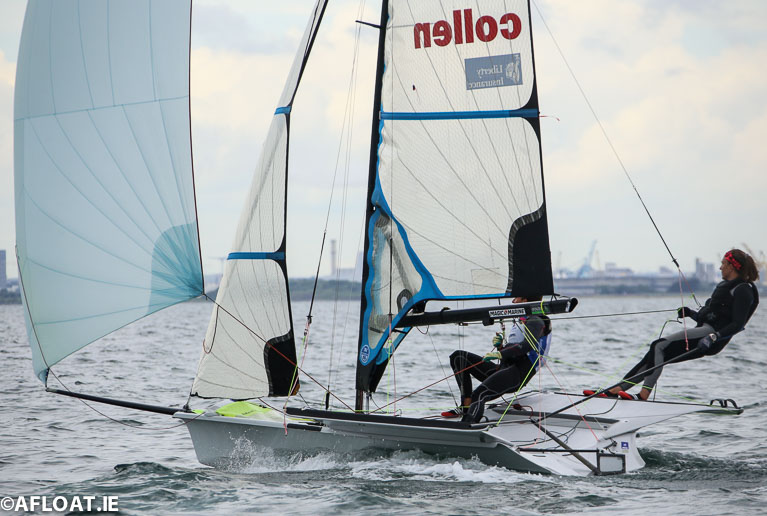 Annalise Murphy in the 49er FX
Annalise Murphy in the 49er FX
 Ryan Seaton and Seafra Guilfoyle in the 49er
Ryan Seaton and Seafra Guilfoyle in the 49er
At Rio 2016, 13 sets of medallists at the test event went on to claim glory at the Games, with 18 replicating podium positions in 2011 and 2012 at the London Olympiad.
Out of those 21 individual sailors involved in 2015 and 2016, 17 of them will line up at Ready Steady Tokyo eyeing similar results, including six who achieved the impressive feat of winning gold at both.
As regular Afloat readers will know silver medal winner Annalise Murphy has switched classes to the 49erFX for Tokyo and will compete in this week's test event but Rio team-mate Ryan Seaton, now sailing with Seafra Guilfoyle, is not competing in the men's 49er skiff ceding the single place to the Howth duo Robert Dickson and Sean Waddilove.
Download the full entry list below
Overall, 30 individual medallists from Rio 2016, as well as an additional 11 from London 2012, are amongst the 363 sailors competing at Ready Steady Tokyo. With only a small percentage already confirmed for next year's Games, the stakes are high on the road to Tokyo 2020, and this week's test event will play a big part in the decisions made before next year.
But it's not just the sailors using this week to test proceedings ahead of 2020. Ready Steady Tokyo will be a perfect opportunity for World Sailing and Tokyo 2020 to finalise their planning for the Olympic Games next year. It also provides a great opportunity for the race management team to test the field of play that will be used at the Games - and all of the Chief Officials appointed to Tokyo 2020 are here too.
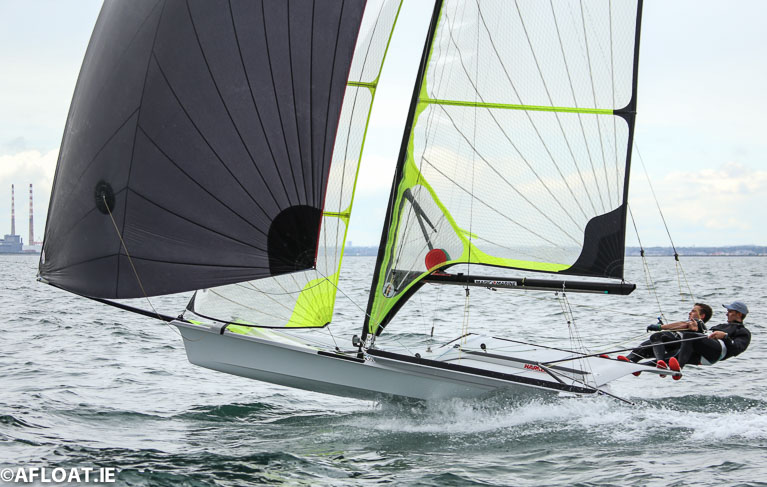 Robert Dickson and Sean Waddilove in the 49er
Robert Dickson and Sean Waddilove in the 49er
49ers Robert Dickson and Sean Waddilove have described how they cool down on the water (a lot of ice in their rash vests), and having a canopy on the boat to protect them from the sun. Each nation has one entry per class, but Ireland has got two in the Laser Radials. That means Ireland is represented by: Aisling Keller and Aoife Hopkins (Laser Radial); Robert Dickson & Sean Waddilove (49er) and Annalise Murphy & Katie Tingle (49erFX).
The second event is the World Sailing World Cup starting in Enoshima on 25th August-1st September. Ireland will have got a full team competing in this: Aoife Hopkins and Aisling Keller in the Laser Radial; Finn Lynch, Liam Glynn and Ewan McMahon in the Laser; Ryan Seaton and Seafra Guilfoyle, Robert Dickson and Sean Waddilove in the 49ers; Annalise Murphy and Katie Tingle in the 49erFX.
How Irish Sailing Teams Qualified for Rio Olympics
The 32–month long Olympic sailing qualification process, incorporating events ranging from Takapuna to Toronto, has concluded with 380 athletes sailing 274 boats that will represent 66 nations in Rio de Janeiro this August.
One nation per event
This process, devised by World Sailing in consultation with the International Olympic Committee (IOC), prioritises performance with later places allocated in accordance with the IOC's principle of universality. With only one nation permitted per event, it can be argued that the process does not allow the Olympics to showcase all the world's best sailors, but the alternative is to have the fleet filled with the top sailors from a smaller number of countries, opening the possibility of a clean sweep of medals by one nation. The Finn, for example, has been a happy hunting ground for British sailors three of whom have won seven out of the last ten Finn Gold Cups. It is not inconceivable that, were multiple entries from a single nation allowed, then GBR could own the podium in this class at least.
Ireland qualifies three at first opportunity
The first qualifying opportunity was at the combined World Championships in Santander in September 2014 where half of the places available for Rio were secured. Ireland's sailors were successful in achieving qualification in the One-person Dinghy Men and Women and the Skiff Men events in Santander.
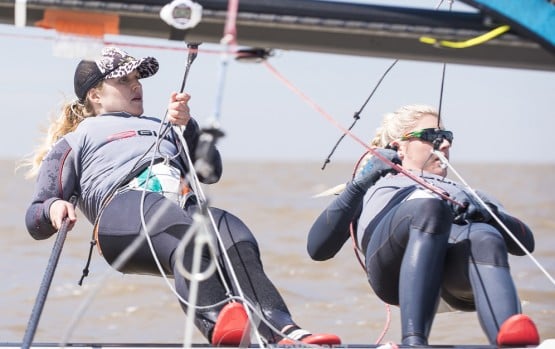 Andrea Brewster and Saskia Tidey confirmed for Rio next month Photo: B Gretz
Andrea Brewster and Saskia Tidey confirmed for Rio next month Photo: B Gretz
Ireland gets African slot
Remaining performance places were allocated to the 2015 Class World Championships and a series of Continental Qualification Events sanctioned by World Sailing, to finish by 1 June 2016 at the latest. Brazil, as host country, get an automatic entry in each event, while 4 places, 2 each in the Laser and Laser Radial classes are reserved for allocation by IOC to smaller nations. The Irish 49erFx qualified through the 2015 Worlds when the place reserved for Africa was not used, thus increasing the original number of places available from the Worlds.
Quality or Quantity? - Some countries reject their places
Things got even more complicated this year as seven countries (Australia, Austria, Canada, Croatia, Germany, New Zealand and Sweden) have decided not to send sailors in qualified classes, thus opening the door for countries lower down the pecking order. In at least three of these countries appeals against these decisions were dismissed by higher authorities. But social media continues the debate and it is sure to be a topic for some time to come.
Lynch overturns Espey, Murphy stays on course
Ireland, in common with many countries, put in place an additional selection system to determine the individuals that would be chosen for Rio. Finn Lynch defeated James Espey in the Laser class to secure selection, while Annalise Murphy held off the challenge of Aoife Hopkins in the Laser Radial. There were no challengers to the Skiff teams of Seaton/McGovern and Brewster/Tidey so these pairs travel to Rio.
Events & Equipment
While sailors traditionally refer to the class of boats they sail, IOC/World Sailing first define events, then equipment as per the following table:
| Event | Equipment | Total Places | 2014 WC | 2015WC | Continental Places | ||
| Men | Women | Mixed | Fleet M/W | ||||
| Windsurfer | RS:X | RS:X | 36/26 | 18/13 | 6/6 | 11/6 | |
| One-person dinghy | Laser | Laser Radial | 46/37 | 23/19 | 9/4 | 11/11 | |
| Heavyweight one-person dinghy | Finn | 23 | 12 | 4 | 6 | ||
| Two-person Dinghy | 470 | 470 | 26/20 | 13/10 | 6/3 | 6/6 | |
| Skiff | 49er | 49erFX | 20/20 | 10/10 | 3/3 | 6/6 | |
| Multihull | Nacra 17 | 20 | 10 | 3 | 6 |
Next: In the next article we take a look at the format of the Olympic Regatta.
Irish Olympic Sailing News
Get the very latest news stories about the Irish Olympic Sailing Team right on Afloat's dedicated Olympic aggregate news page. Afloat covers all the Olympic classes relevant to Ireland and our stories cover the road to Olympic qualification right through to Irish Olympic sailing Team News, Schedules and Results from the Olympic regatta itself.
Click HERE for Paris 2024 news Click HERE for Tokyo 2021 news, click HERE for Rio 2016 archive and click HERE for London 2012 archive
Annalise Murphy is Miami Medal Prospect
The strong Dun Laoghaire girl relished the prospects of the big winds that blew at times on Biscayne Bay this week. Consistent results of 5, 15, 2, 2, 5, 6 11,9, (21) and 5 never saw her out of the top five.
Tuesday saw her bag two second places in a fleet of 58. It was a turning point in a regatta that she crashed out of last year only to return wth grit to be Ireland's only medal hope today.
Last night's move up to fourth overall on the scoreboard is another confidence boost, heightening the prospect of a place on this evening's podium. Conditions in Miami today are forcast to be light, probably not the conditions the National Yacht club girl would have hoped for.
In the Star Peter O'Leary and his crew for his London 2012 bid David Burrows finished with a strong fifth place yesterday but it was not enough to make today's final. They finished 13th overall after counting a black flag disqualification on day two of the event. See all results HERE.
Rival to Annalise, Tiffany Brien from Belfast Lough finished 21st overall.
Her club mate Jame Espey was 49th out of 52 after 7 races in the Laser gold fleet.
More from Miami organisers below:
Waking to a brisk northwesterly breeze, sailors at US SAILING’s Rolex Miami OCR yesterday made up for races lost to light air Wednesday. The conditions, though chilly by Florida standards, played out perfectly for medals to be determined in three Paralympic classes, while 10 Olympic classes fought their final battles for the right to compete in tomorrow’s medal races, which are comprised of top-ten “sail-offs” for Finn, 49er, Men’s 470, Women’s 470, Laser, Laser Radial, Men’s RS:X, Women’s RS:X and Star classes, and Finals and Petit Finals for Elliott 6m (women’s match racing). The regatta, which began Monday for 716 sailors from 53 nations, prepares Olympic and Paralympic sailing aspirants for the 2012 Games and is the second of seven stops on the International Sailing Federation (ISAF) Sailing World Cup circuit.
For France’s Damien Seguin, a two-time 2.4mR IFDS World Champion who is currently ranked #1 in the world, winning gold in the Paralympic 2.4mR class was looking good from day two when he assumed the lead over his 30-boat fleet. Clinching today, however, was not as straightforward as today’s scores seemed to reflect. Following seven boat lengths behind leader USA’s John Ruf (Pewaukee, Wis.) at the finish in race one, Seguin was determined the actual winner when Ruf was disqualified for starting the race prematurely and neglecting to exonerate himself. “After that, for my next two races, my score was such that I needed only to loosely cover Thierry Schmitter (NED),” said Seguin, further explaining that only if he finished worse than sixth would he foil his own plot. Schmitter, another IFDS World Champion, took the Silver Medal, finishing fourth in the first race and winning the next two, each time with Seguin behind in second.
“There were many different winds here,” said Damien about the practice this provides for his run for a spot on the French national team. “We started in strong wind, then there was light wind and today medium-strong. I am very happy for that and for the competition.”
Taking bronze was Canada’s Allan Leibel, who is able-bodied and allowed to compete here, since the class is declared “open” for this event.
The Gold Medal taking in the Paralympic Sonar class by GBR’s John Robertson/Hannah Stodel/Steve Thomas came with an intriguing twist today. With two races completed, the Dutch team of Udo Hessels/Mischa Rossen/Marcel van de Veen were in the lead, and surprisingly, they did not sail the third and final race.
“There were two points between us and the Dutch, so no one will ever know how it would have played out on the water,” said Robertson, explaining that he understands Hessel’s middle crew Rossen, a single-arm amputee, had been having problems with his opposite shoulder and the team had decided beforehand to race no more than two races today.
Robertson’s team, which took the Silver here last year, posted a final score of 30 to the 36 points posted by silver medalists Bruon Jourdren/Eric Flageul/Nicolas Vimont Vicary (FRA). The Dutch team, with 37 points, is going home with the Bronze.
As for his team’s overall strategy here, Robertson said, “We tried to sail our own race and not get hung up with the other guys. Hanna did a fantastic job calling tactics, especially today, as the wind was up and down and all over the place, with 40-50 degree shifts.”
The Australian Paralympic SKUD 18 team of Daniel Fitzgibbon/Liesl Tesch has led their fleet since day one and boasted six victories in their nine-race score line to take the Gold medal. Today they finished 1-1-2.
“We didn’t walk away with it, really, but we were comfortably ahead,” said Fitzgibbon, who won a Paralympic Silver Medal (with a different crew) in Qingdao. "We didn’t expect to have done so well with such a new combination,” he added, noting that he and Tesch, who gave up Paralympic basketball (she is a two-time medalist) for her new-found love of sailing, have only been together on the SKUD 18 for a few weeks. “It’s a new challenge for her and a breath of fresh air for everybody.”
Taking Silver was US Sailing Team AlphaGraphics’ Scott Whitman/Julia Dorsett (USA), with Alexandra Rickham/Niki Birrell (GBR) taking the Bronze.
Medal Races Tomorrow
Top-ten finishers from today in each of nine Olympic classes will get only one chance--a 30- to 40-minute race—to make or break their claim to a podium position. Emulating the Olympic format, the medal race counts double points and cannot be counted as the one allowed discard race when it is added to a sailor’s score line from the rest of the series.
In women’s match racing, US Sailing Team AlphaGraphics members Anna Tunnicliffe(/Molly Vandemoer/Debbie Capozzi (Plantation, Fla., USA/Redwood City, Calif./Bayport, N.Y., USA) will meet Claire Leroy/ Elodie Bertrand/Marie Riou (FRA) in a first-to-three points Finals match tomorrow to determine Gold and Silver medalists. Lucy Macgregor/Mary Rook/ Kate Macgregor (GBR) and Sally Barkow (Nashotah, WI., USA)/ Alana O’Reilly (Charleston SC, USA)/ Elizabeth Kratzig-Burnham (Miami Beach FL, USA) will be fighting for bronze in the Petit Finals.
Match racing starts on its own course at 9:30 tomorrow, with fleet racing starting at 11:00 am on two additional courses. Fleet races are planned to be approximately 30 minutes in length and started 40 minutes apart. No racing will start after 1:40 p.m., so it will be an early day.
US SAILING has partnered with the city of Miami to provide world-class venues for competition. Additional hosts for the event include Coral Reef Yacht Club, Key Biscayne Yacht Club, Coconut Grove Sailing Club, Miami Rowing Club and Shake-a-Leg Miami. These sailing organizations host classes onshore, as well as help run the on-the-water racing. The Coral Reef Yacht Club also hosts the Opening and Closing Ceremonies.
In addition to title sponsor Rolex Watch U.S.A., US SAILING’s 2011 Rolex Miami OCR is also sponsored by AlphaGraphics, Gowrie Group, Chubb Insurance, Sperry Top-Sider, Harken McLube, Trinity Yachts, University of Miami Hospital and Kattack.
A complete roster of competitors can be viewed at the event website, RMOCR.ussailing.org, where real-time racecourse blogging, commentary and fan interaction, regatta results, photos and news updates will be integrated into a live coverage platform once racing begins. Video highlights produced by Gary Jobson and presented by Rolex air daily and are available on-demand on the event website. Fans can also follow the event on Facebook/RolexMiamiOCR and Twitter/RolexMiamiOCR.
More in our Olympics 2012 category HERE
Ireland Guaranteed Medal in the Star Class Today (Podcast here)
Ireland is guaranteed a medal today at the British Skandia Sail for Gold regatta in the Star class but Peter O'Leary's clean run in the keelboat this week was not without drama yesterday when his crew Fritjof Kleen slipped overboard 300 metres from the finish line.
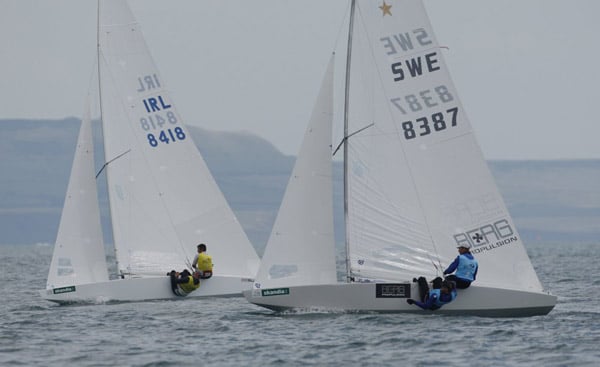
Peter O'Leary and Frithjof Kleen (IRL) against Fredrik Loof and Johan Tillannder (SWE) in the Star class on day 5 of the Skandia Sail for Gold Regatta. Photo: onEdition


























